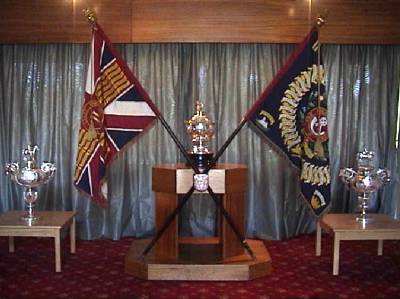
A Short History of Colours

Origin of Colours
The origin of the custom of carrying Colours goes back to the days of early man, who fixed his family badge to a pole and held it aloft in battle for the dual purpose of indicating his position and acting as a rallying point should the occasion arise. Medieval chivalry followed the same idea when armorial bearings were placed on their banners so that these could be seen well above the melee. When armies were begin-ning to adopt a system of regimentation at the beginning of the 17th century each company was allotted a Colour, a custom which persisted for about a hundred years.
Standards and Guidons
These have evolved from the banners of the knights of the Middle Ages. The Standard (a square banner) was then carried by a knight; the Guidon (an ensign or standard ending with a tail or point, now swallow tailed) being carried by a banneret. When a banneret was created a knight the point of his Guidon was cut off, thus trans-forming it into a Standard.
Royal Artillery
The Colours
of the Royal Regiment of Artillery are its weapons, which are its
guns, and its rockets and missiles (including man-portable
weapons) when these are mounted on or in a launcher. When on
parade on ceremonial occasions, these weapons are accorded the
same compliments as the Standards, Guidons and Colours of the
Household Cavalry, Royal Armoured Corps and Infantry. It is
impracticable in modern times to consider the weapons of the
Royal Artillery as Colours on non-ceremonial occasions but they
are always treated with dignity and respect.
The guns became the Colours of the Regiment through the practice
in its early history of carrying the equivalent of today's King's
Colour on the largest piece in an artillery train, which was
designated the 'Flag Gun'. The Flag Gun was used until the end of
the 18th century and after this period the guns themselves came
to be regarded as the Colours of the Artillery.
Infantry
In 1751
infantry regiments were allowed two Colours (King's and
Regimental), and this arrangement has continued to the present
day. The practice of carrying Colours into action continued until
the beginning of 1881 during the first Boer War in South Africa
when the custom was discontinued because of the altered form of
attack and the increased range of musketry.
Certain regiments have the right to carry three Colours on parade
but this right is only exercised by the Royal Highland Fusiliers
who carry the Assaye Colour, the original of which was presented
by the East India Company to commemorate the brave conduct of the
regiment at the Battle of Assaye. Two other regiments also
received this honour.
Rifle Regiments
Rifle Regiments, with one exception, do not carry Colours since their original duty was to skirmish ahead of the main body, where speed and concealment were essential to success. The exception is the 2nd King Edward Vll's Own Gurkha Rifles (Sirmoor Rifles), who were granted a Truncheon by Queen Victoria for distinguished services at Delhi in 1857. This Truncheon, which is carried on ceremonial parades, represents in all respects a Colour.
Cavalry
In the Cavalry, the counterpart of Rifles are Lancers and Hussars and these gave up their Guidons when made Light Cavalry. However, with the passing of the horse and changing circumstances, there is now no difference in the roles of Heavy or Light Cavalry. Guidons are now carried by Hussar and Lancer regiments, whilst the Household Cavalry, Dragoon Guards and the Royal Tank Regiment carry Standards.
Symbolism
Colours have become the symbol of the spirit of a regiment, for they bear the battle honours and badges granted to the regiment in commemoration of the gallant deeds performed by its members from the time it was raised. This association of Colours with heroic deeds has caused them to be regarded with veneration. The fact that Colours are consecrated before being taken into use, and after service are laid up in sacred or public buildings, helps to maintain the atmosphere of veneration with which they are surrounded.